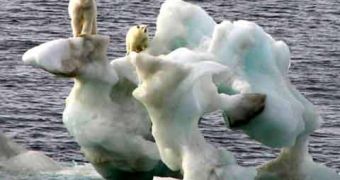The news regarding climate change has recently gone from bad to the very worst. By predicting the weather and ocean conditions in the following months researchers discovered that there is a relatively good chance than at the end of this summer there will be little or no ice left at the North Pole. The probability of 2008 marking the first year in recorded history with no ice at the North Pole is about 50 percent.
Senior researcher Mark Serreze of the National Snow and Ice Data Center and the University of Colorado, argues that the probability rate is so high because the ice layers at the North Pole are thinner than they have ever been. "A large area at the North Pole and surrounding the North Pole is first-year ice. That's the stuff that tends to melt out in the summer because it's thin," he said.
Observations from NASA satellites clearly show that the ice in the vicinity of the North Pole has been steadily thinning in the last five years or so, although they predict a probability of total ice meltdown this year slightly lower than the 50 percent estimated by Serreze.
According to Serreze, a total ice melting at the North Pole doesn't bear significant scientific relevance, although it will have some cultural and symbolic impact throughout the world. Last year, for example, the Northwest Passage was ice free for the first time in history, thus allowing maritime navigation.
There is a 1 in 4 chance that the North Pole will become completely free of ice this year, says Cecilia Bitz of the University of Washington, while some previous climate change models pointed towards a 1 in 70 chance that this would happen in a decade.
"I would guess within the next 10 year it would happen at least once," Bitz said.
Current data shows that the ice levels in the whole Arctic region are similar to the low point levels registered in June and July 2007, which indicated a continuous rise in global temperature.
The melting of the ice sheet covering the Arctic Ocean has been taking place at a steady pace during the last decades with the rise in temperature, culminating last winter with the birth of a new weather phenomenon similar to the El Nino but manifested through cold temperatures. This is called Arctic Oscillation, a change in wind patterns, which resulted in the acceleration of ice melting, leaving behind only a thin one year layer of ice that may disappear altogether this summer.

 14 DAY TRIAL //
14 DAY TRIAL //